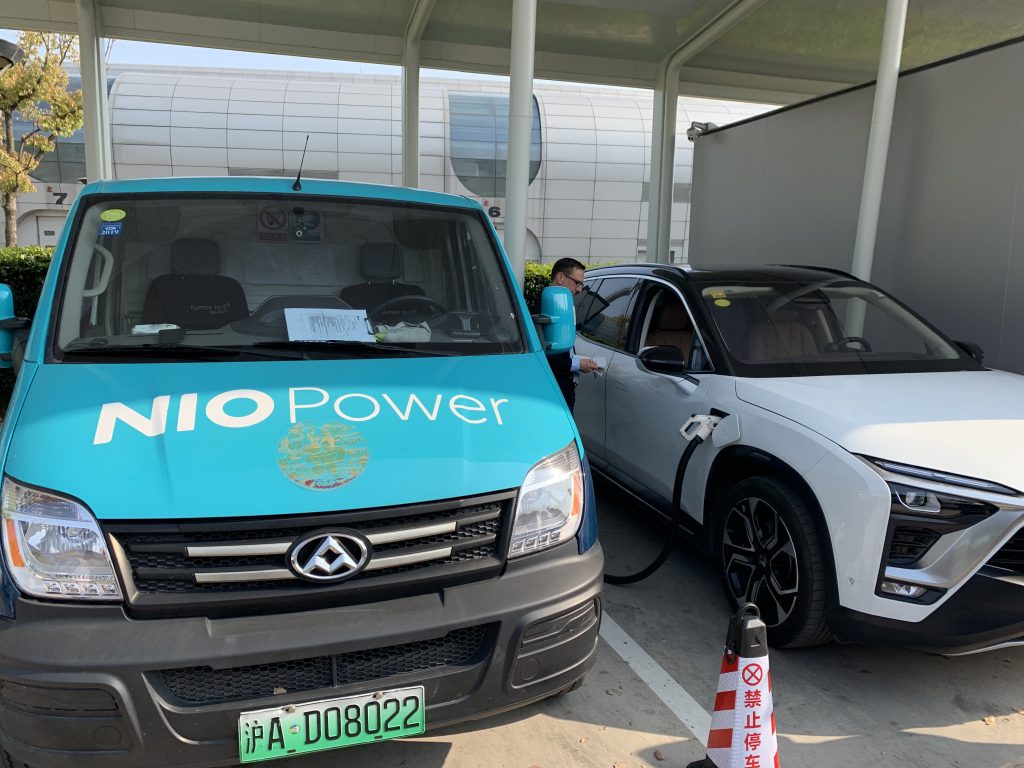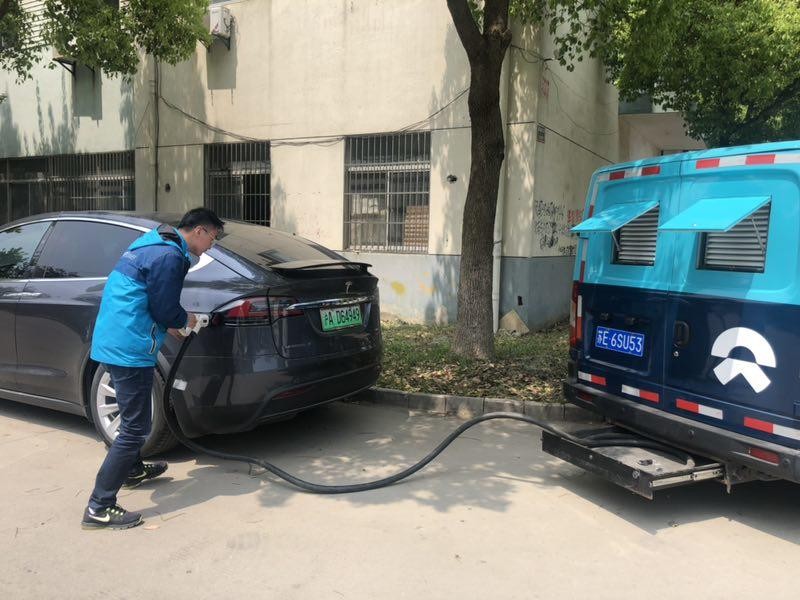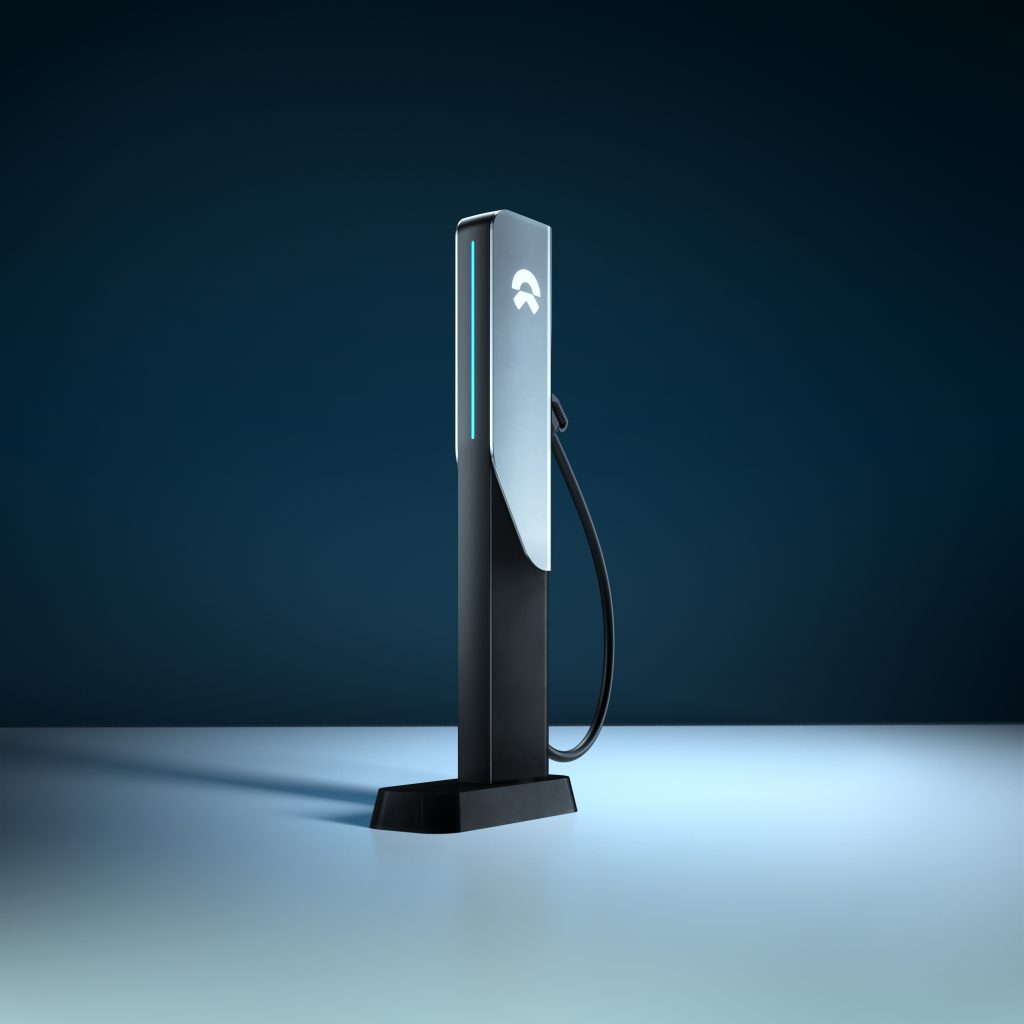

News
China’s NIO expands mobile charging service to all electric cars, including Tesla
China’s NIO announced at the Shanghai Auto Show that any electric vehicle will soon be able to use their “One Click for Power” services. The service allows EV owners to order valet charging and mobile charging vans right from the NIO app.
NIO, founded in 2014, began production of their first vehicle last year and has since delivered over 15,000 vehicles. Up until this point, the NIO Power services have only been available to NIO owners. The services division includes the company’s quickly growing rapid charging network, charging vans, and battery swap stations. Shen Fei, VP of NIO Power, stated that the company has had several owners order power services seeking to charge their other electric vehicles, including several Teslas. While the company had accommodated those owners in the past, they are now opening up the services to all types of electric vehicles.

While nearly all EV owners in the US and Europe charge at home, it can be difficult to install in-home chargers in China. Fei stated that 22% of NIO owners lack home charging stations, creating a need for other power solutions. While public chargers are becoming quite prevalent in most major Chinese cities, NIO’s One Click for Power services allows owners to skip the trip to the charging station.
The China-based electric car maker highlighted that NIO owners have used the service over 93,000 times since the company started vehicle deliveries last year. Approximately 70% of NIO owners have used the One Click for Power service, indicating that there is a real desire for flexible charging solutions.

On the same day that NIO announced the expansion of their power services to other EVs, NIO was charging up a customer’s Tesla (the customer owned both a Tesla and a NIO ES8). Other EV owners, including Tesla owners, will be able to pay just 280 yuan ($42 USD) through NIO’s WeChat mini-app to have their vehicle charged. The company has more than 510 mobile charging vans across 95 cities in China.
NIO CEO William Li told Teslarati that he sees the expansion of their services business as an opportunity to both grow revenue and expose more users to the NIO brand. “Lots of EV owners want to have better [charging] service and we have the capability to serve them,” Li stated. “Even if they don’t want to buy our car, we can introduce our brand and our service to other buyers. I think it’s very good for us,” he said.

In addition to expanding their power services, NIO also unveiled a new DC-fast charging station. The company previously partnered with ABB to deploy 60 kW fast-charging stations across China. NIO’s new DC fast chargers are far more compact than the previous generation chargers and now have a charging capacity of 105 kW.
NIO debuted on the New York Stock Exchange last fall and has since been on a bit of a rollercoaster as investors react to changing market conditions in China. Despite the swings in value, NIO is focused on servicing its growing customer base. The company now has ~9,500 employees globally, including a team of more than a 1,000 NIO Power service workers. NIO expects to start deliveries of their mid-size SUV, the ES6, in June which starts at ¥358,000 ($53,500) and delivers 315 miles of range.

Elon Musk
Elon Musk and Tesla AI Director share insights after empty driver seat Robotaxi rides
The executives’ unoccupied tests hint at the rapid progress of Tesla’s unsupervised Robotaxi efforts.

Tesla CEO Elon Musk and AI Director Ashok Elluswamy celebrated Christmas Eve by sharing personal experiences with Robotaxi vehicles that had no safety monitor or occupant in the driver’s seat. Musk described the system’s “perfect driving” around Austin, while Elluswamy posted video from the back seat, calling it “an amazing experience.”
The executives’ unoccupied tests hint at the rapid progress of Tesla’s unsupervised Robotaxi efforts.
Elon and Ashok’s firsthand Robotaxi insights
Prior to Musk and the Tesla AI Director’s posts, sightings of unmanned Teslas navigating public roads were widely shared on social media. One such vehicle was spotted in Austin, Texas, which Elon Musk acknowleged by stating that “Testing is underway with no occupants in the car.”
Based on his Christmas Eve post, Musk seemed to have tested an unmanned Tesla himself. “A Tesla with no safety monitor in the car and me sitting in the passenger seat took me all around Austin on Sunday with perfect driving,” Musk wrote in his post.
Elluswamy responded with a 2-minute video showing himself in the rear of an unmanned Tesla. The video featured the vehicle’s empty front seats, as well as its smooth handling through real-world traffic. He captioned his video with the words, “It’s an amazing experience!”
Towards Unsupervised operations
During an xAI Hackathon earlier this month, Elon Musk mentioned that Tesla owed be removing Safety Monitors from its Robotaxis in Austin in just three weeks. “Unsupervised is pretty much solved at this point. So there will be Tesla Robotaxis operating in Austin with no one in them. Not even anyone in the passenger seat in about three weeks,” he said. Musk echoed similar estimates at the 2025 Annual Shareholder Meeting and the Q3 2025 earnings call.
Considering the insights that were posted Musk and Elluswamy, it does appear that Tesla is working hard towards operating its Robotaxis with no safety monitors. This is quite impressive considering that the service was launched just earlier this year.
Elon Musk
Starlink passes 9 million active customers just weeks after hitting 8 million
The milestone highlights the accelerating growth of Starlink, which has now been adding over 20,000 new users per day.

SpaceX’s Starlink satellite internet service has continued its rapid global expansion, surpassing 9 million active customers just weeks after crossing the 8 million mark.
The milestone highlights the accelerating growth of Starlink, which has now been adding over 20,000 new users per day.
9 million customers
In a post on X, SpaceX stated that Starlink now serves over 9 million active users across 155 countries, territories, and markets. The company reached 8 million customers in early November, meaning it added roughly 1 million subscribers in under seven weeks, or about 21,275 new users on average per day.
“Starlink is connecting more than 9M active customers with high-speed internet across 155 countries, territories, and many other markets,” Starlink wrote in a post on its official X account. SpaceX President Gwynne Shotwell also celebrated the milestone on X. “A huge thank you to all of our customers and congrats to the Starlink team for such an incredible product,” she wrote.
That growth rate reflects both rising demand for broadband in underserved regions and Starlink’s expanding satellite constellation, which now includes more than 9,000 low-Earth-orbit satellites designed to deliver high-speed, low-latency internet worldwide.
Starlink’s momentum
Starlink’s momentum has been building up. SpaceX reported 4.6 million Starlink customers in December 2024, followed by 7 million by August 2025, and 8 million customers in November. Independent data also suggests Starlink usage is rising sharply, with Cloudflare reporting that global web traffic from Starlink users more than doubled in 2025, as noted in an Insider report.
Starlink’s momentum is increasingly tied to SpaceX’s broader financial outlook. Elon Musk has said the satellite network is “by far” the company’s largest revenue driver, and reports suggest SpaceX may be positioning itself for an initial public offering as soon as next year, with valuations estimated as high as $1.5 trillion. Musk has also suggested in the past that Starlink could have its own IPO in the future.
News
NVIDIA Director of Robotics: Tesla FSD v14 is the first AI to pass the “Physical Turing Test”
After testing FSD v14, Fan stated that his experience with FSD felt magical at first, but it soon started to feel like a routine.

NVIDIA Director of Robotics Jim Fan has praised Tesla’s Full Self-Driving (Supervised) v14 as the first AI to pass what he described as a “Physical Turing Test.”
After testing FSD v14, Fan stated that his experience with FSD felt magical at first, but it soon started to feel like a routine. And just like smartphones today, removing it now would “actively hurt.”
Jim Fan’s hands-on FSD v14 impressions
Fan, a leading researcher in embodied AI who is currently solving Physical AI at NVIDIA and spearheading the company’s Project GR00T initiative, noted that he actually was late to the Tesla game. He was, however, one of the first to try out FSD v14.
“I was very late to own a Tesla but among the earliest to try out FSD v14. It’s perhaps the first time I experience an AI that passes the Physical Turing Test: after a long day at work, you press a button, lay back, and couldn’t tell if a neural net or a human drove you home,” Fan wrote in a post on X.
Fan added: “Despite knowing exactly how robot learning works, I still find it magical watching the steering wheel turn by itself. First it feels surreal, next it becomes routine. Then, like the smartphone, taking it away actively hurts. This is how humanity gets rewired and glued to god-like technologies.”
The Physical Turing Test
The original Turing Test was conceived by Alan Turing in 1950, and it was aimed at determining if a machine could exhibit behavior that is equivalent to or indistinguishable from a human. By focusing on text-based conversations, the original Turing Test set a high bar for natural language processing and machine learning.
This test has been passed by today’s large language models. However, the capability to converse in a humanlike manner is a completely different challenge from performing real-world problem-solving or physical interactions. Thus, Fan introduced the Physical Turing Test, which challenges AI systems to demonstrate intelligence through physical actions.
Based on Fan’s comments, Tesla has demonstrated these intelligent physical actions with FSD v14. Elon Musk agreed with the NVIDIA executive, stating in a post on X that with FSD v14, “you can sense the sentience maturing.” Musk also praised Tesla AI, calling it the best “real-world AI” today.








